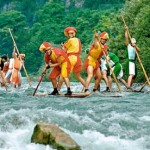Palio delle Zattere
In 1987, furthermore, on the last Sunday of July, the first Palio delle Zattere Raft Race took place in Valstagna in memory of a profession that made this valley important. The 9 districts or contradas (Oliero, Londa, San Marco, Torre, Mori, Fantoli, San Gaetano, Sasso Stefani and Costa) parade through the streets and every year bring the rafts to the starting point of one of the most important summer events in the area with the symbol of Saint Nicolò, patron saint of the raftsmen at the head of the parade: all nine contradas of the Municipality of Valstagna have a raft with three raftsmen who have to show force, resistance, shrewdness and determination to keep the honour and history of each contrada afloat. These rafts are positioned herringbone style and when the starting gun fires, they ride the waves down to the central area of Valstagna to face the intermediary test of the damsels. Only after correctly passing the test may they head towards the finish line at the Rialto bridge, resplendent with flags bearing the colours of the contradas.
The starting order is determined the night before the race by a sled-dragging competition combined with a trunk-splitting contest which make up the palio preview. The evening event includes the presentation of the teams of three raftsmen and a damsel. Tension runs high because if the teams to manage to place their raft in a favourable position it obviously gives their contrada an advantage, even if it must be stressed that the final result is not certain until the last few strokes of the race.
The Palio delle Zattere raft race came about as a competition between the little villages and contradas of Valstagna, who race each other to win a prestigious palio tapestry by racing down the waters of the Brenta in a charming panoramic section of the river. The event becomes even more engaging because the valley folk, first with canoes and then with rafts, seem to reconcile themselves with the river after the terrible flood of 1966 and the tragic Brentanon flood of 31st July 1851. It is the rediscovery of the Brenta river and of certain activities linked to the lives of the valley folk in the past: timber floating and trading, sawmills and flour mills, forges, paper mills and spinning mills. Pages of centuries-old history have been penned with first the menadas – free floating of trunks, then with the rafts and most of the population of Valstagna, Oliero, San Nazario and Campolongo practised the harsh trade of the zattiere. The centre of the valley became the main station (from which Stazi) for timber storage and trade, which was floated down there from various places to then reach the unloading points at Bassano and the plains down to Porto di Bassanello in Padua and the Arsenal in Venice.
The race devised by the Pro Loco recreational association in 1987 has had great success over the years with thousands of tourists attending, enjoying the heady atmosphere of the event, watching the spectacle of the historic parade through the streets of Valstagna, accompanied by its various participants and the gaily-coloured contradas with their respective costumes. The Zattere raft crews consist of three raftsmen and a damsel. Normally nine contradas take part. Since 2005 Valstagna has been a Timber Rafting City as declared by the International Timber Raftsmen Association. The winner is awarded the Palio, a red velvet tapestry bearing the crest of the Municipality of Valstagna, which is kept by the winning contrada for a year, until the next raft race.

